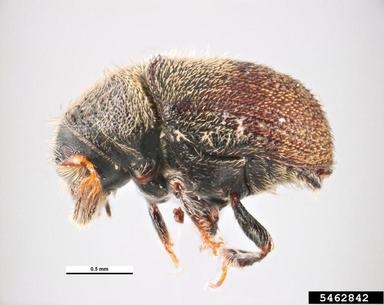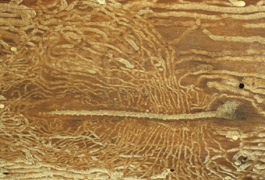Below is a brief description of the new pest, followed by CDFA's analysis.
Olive bark beetle
(Phloeotribus scarabaeoides)
Prepared by Dr. G. Arakelian, Senior Biologist, Los Angeles County Department of Agricultural Commissioner/Weights and Measures, February, 2017
Distribution: Widely distributed in southern Europe, North Africa and Middle East.
In the US: California.
Field ID: Adults (2.0-2.5 mm long) have dark brown to black bodies densely covered with yellowish hairs. Antennal club with three distinctive movable, leaf-like segments.
Larvae (about 3.0 mm long) are white, legless and with brown heads.
Hosts and damage: Attack olive trees. They were recorded also on oleander, ash and common lilac. Olive bark beetles may have several generations per year.
Adult female enters the bark and bores a tunnel where she lays up to 60 eggs. Hatched larvae excavate new galleries underneath the bark often completely girdling and weakening branches.
Severe infestations may stunt the growth of young trees and reduce number of flowers and olive fruits.
Phloeotribus scarabaeoides (Bernard):
Olive Bark Beetle (OBB)
California Pest Rating Proposal
Phloeotribus scarabaeoides (Bernard): Olive Bark Beetle (OBB)
Coleoptera: Cucurlionidae:
Current Rating: Q
Proposed Rating: B
Initiating Event:
On October 18, 2016 Dr. Andrew Cline identified a sample of bark beetles obtained from an olive tree at a grape vineyard in Riverside County as Phloeotribus scarabaeoides, the olive bark beetle (OBB). This is the first record of OBB in the Western Hemisphere and a pest rating proposal is required to assign a permanent pest rating.
History & Status:
Background: OBB is a bark beetle that is a well-known pest of olive1. The species is widely distributed around the Mediterranean basin1,3 (including Europe, North Africa, and parts of Asia). Adult females bore through bark and excavate a transverse tunnel on either side of the entry point1. Inside the twig/branch, the female lays up to 60 eggs and as larvae hatch each larva bores up or down from the entrance tunnel underneath the bark1. This feeding causes partial to complete girdling1 of the twig/branch; thereby structurally weakening it as well as damaging vasculature. Larvae pupate inside the feeding galleries1. OBB has 2-4 generations per year1. Spring and early summer adults tend to lay eggs in prunings and olive wood stacked as firewood rather than living trees1. In addition to olive, OBB also feeds on oleander (Nerium oleander) and occasionally ash (Fraxinus excelsior) and lilac (Syringa vulgaris)1. OBB may be transported long distances when infested olive wood or living plants are moved.
Worldwide Distribution: OBB is native to the Mediterranean basin. Thus far, it is not known to have invaded any other regions.
Official Control: OBB is listed as a harmful organism by Japan, Paraguay, and Peru2.
California Distribution: OBB has been found at the grape vineyard as well as a residence and 3 nurseries, all in Riverside County. Surveys of olive trees at nurseries in other counties have not found any OBB.
California Interceptions: OBB has never been found in any regulatory situations in California. However, the beetles have been found in trees at three nurseries and might have been spreading through the nursery trade for an indefinite time period.
The risk Phloeotribus scarabaeoides [olive bark beetle (OBB)] would pose to California is evaluated below.
Consequences of Introduction:
1) Climate/Host Interaction: Olive and oleander are grown throughout California and OBB is likely to establish throughout these areas. It receives a High (3) in this category.
Evaluate if the pest would have suitable hosts and climate to establish in California.
Score: 3
– Low (1) Not likely to establish in California; or likely to establish in very limited areas.
– Medium (2) may be able to establish in a larger but limited part of California.
– High (3) likely to establish a widespread distribution in California.
2) Known Pest Host Range: OBB feeds primarily on olive, secondarily on oleander, and occasionally on ash and lilac. It receives a Low (1) in this category.
Evaluate the host range of the pest.
Score: 1
– Low (1) has a very limited host range.
– Medium (2) has a moderate host range.
– High (3) has a wide host range.
3) Pest Dispersal Potential: OBB has three to four generations per year and each female lays up to 60 eggs. Adult beetles can fly and all life stages can be transported long distances when olive wood or infested plants are moved. OBB receives a High (3) in this category.
Evaluate the natural and artificial dispersal potential of the pest.
Score: 3
– Low (1) does not have high reproductive or dispersal potential.
– Medium (2) has either high reproductive or dispersal potential.
– High (3) has both high reproduction and dispersal potential.
4) Economic Impact: OBB is considered a serious pest of olive that can cause heavy losses of young shoots, flowers, and fruit1. The beetle can be expected to increase crop production costs for olive growers as they implement management strategies. In regions with established OBB populations, growers are forced to alter cultural practices by moving olive prunings and wood far away from groves to reduce damage. OBB receives a High (3) in this category.
Evaluate the economic impact of the pest to California using the criteria below.
Economic Impact: A, B, D
A. The pest could lower crop yield.
B. The pest could lower crop value (includes increasing crop production costs).
C. The pest could trigger the loss of markets (includes quarantines).
D. The pest could negatively change normal cultural practices.
E. The pest can vector, or is vectored, by another pestiferous organism.
F. The organism is injurious or poisonous to agriculturally important animals.
G. The organism can interfere with the delivery or supply of water for agricultural uses.
Economic Impact Score: 3
– Low (1) causes 0 or 1 of these impacts.
– Medium (2) causes 2 of these impacts.
– High (3) causes 3 or more of these impacts.
4) Environmental Impact: OBB is not expected to lower biodiversity, disrupt natural communities, or change ecosystem processes. The species is not likely to directly affect threatened or endangered species or disrupt critical habitats. OBB is likely to trigger new official and private treatment programs. Olive and oleander are widespread ornamentals and are likely to be significantly impacted by this pest. OBB receives a High (3) in this category.
Evaluate the environmental impact of the pest on California using the criteria below.
Environmental Impact: D, E
A. The pest could have a significant environmental impact such as lowering biodiversity, disrupting natural communities, or changing ecosystem processes.
B. The pest could directly affect threatened or endangered species.
C. The pest could impact threatened or endangered species by disrupting critical habitats.
D. The pest could trigger additional official or private treatment programs.
E. The pest significantly impacts cultural practices, home/urban gardening or ornamental plantings.
Score the pest for Environmental Impact.
Environmental Impact Score: 3
– Low (1) causes none of the above to occur.
– Medium (2) causes one of the above to occur.
– High (3) causes two or more of the above to occur.
Consequences of Introduction to California for Phloeotribus scarabaeoides (Olive bark beetle (OBB)): High (13)
Add up the total score and include it here.
–Low = 5-8 points
–Medium = 9-12 points
–High = 13-15 points
6) Post Entry Distribution and Survey Information: OBB has only been found in Riverside County. It receives a Low (-1) in this category.
Evaluate the known distribution in California. Only official records identified by a taxonomic expert and supported by voucher specimens deposited in natural history collections should be considered. Pest incursions that have been eradicated, are under eradication, or have been delimited with no further detections should not be included.
–Not established (0) Pest never detected in California, or known only from incursions.
–Low (-1) Pest has a localized distribution in California, or is established in one suitable climate/host area (region).
–Medium (-2) Pest is widespread in California but not fully established in the endangered area, or pest established in two contiguous suitable climate/host areas.
–High (-3) Pest has fully established in the endangered area, or pest is reported in more than two contiguous or non-contiguous suitable climate/host areas.
Final Score:
The final score is the consequences of introduction score minus the post entry distribution and survey information score: Medium (12)
Uncertainty:
OBB might have a widespread distribution in California. The beetles have been found in olive trees in several nurseries and it is possible that the beetles could have been spreading through the nursery industry for several years. Secondly, there is a native bark beetle (Hylesinus californicus) that sometimes attacks stressed olive trees and was originally called the olive bark beetle in California. However, the common name was changed to western ash bark beetle to reflect its typical host. It is possible that OBB could be more widespread in California and its damage attributed to Hylesinus californicus. However, adults of Phloeotribus are extremely characteristic amongst all weevils in possessing elongate terminal antennomeres and would be recognized as something new by any coleopterist. Thirdly, the olive trees at the original detection site had been moved from San Diego County. It is possible the beetles could be established in San Diego County, although none have been found at the origin. This evidence suggests the possibility OBB could have a widespread distribution within southern California and possibly the entire State.
Before the olive fly (Bactrocera oleae) arrived in California in 2008 the State was the source of 11% of the world's table olives. Most of these were produced by small growers with less than 40 acres. These growers did not make enough profit to pay for treatment costs for olive fly and many of them have switched to less profitable olive oil. The presence of OBB in California could be especially disastrous for the many small olive growers in the State. This might lead growers to switch to more water intensive crops, exacerbating the effects of the State's drought.
Conclusion and Rating Justification:
Phloeotribus scarabaeoides is expected to have significant economic and environmental impacts to California's olive industry and ornamental plantings of oleander and olive throughout the State. However, it is established and abundant in Riverside County, is not under official control, and has likely been spreading through the nursery trade. There are no approved treatments or survey tools for this pest and there are no plans for an interior quarantine. A “B” rating is justified.
References:
1 Alvord, D.V. 2014. Pests of Fruit Crops: A Color Handbook. CRC Press. 462pp.
2 USDA Phytosanitary Certificate Issuance & Tracking System (PCIT) Phytosanitary Export Database (PExD). https://pcit.aphis.usda.gov/pcit/
3 Knížek, M. 2011. Subfamily Scolytinae. pgs. 204-250. In Lobl, I and A. Smetana (Eds.), Catalogue of Palearctic Coleoptera. Volume 7. Apollo Books, Stenstrup. 372pp.
Responsible Party:
Jason Leathers, 1220 N Street, Sacramento, CA, 95814, (916) 654-1211, plant.health[@]cdfa.ca.gov.
Photos:
Adult
Galleries under bark, by D. Delgado (Riverside Co. Agricultural Commissioner's Office)
Attached Images:

